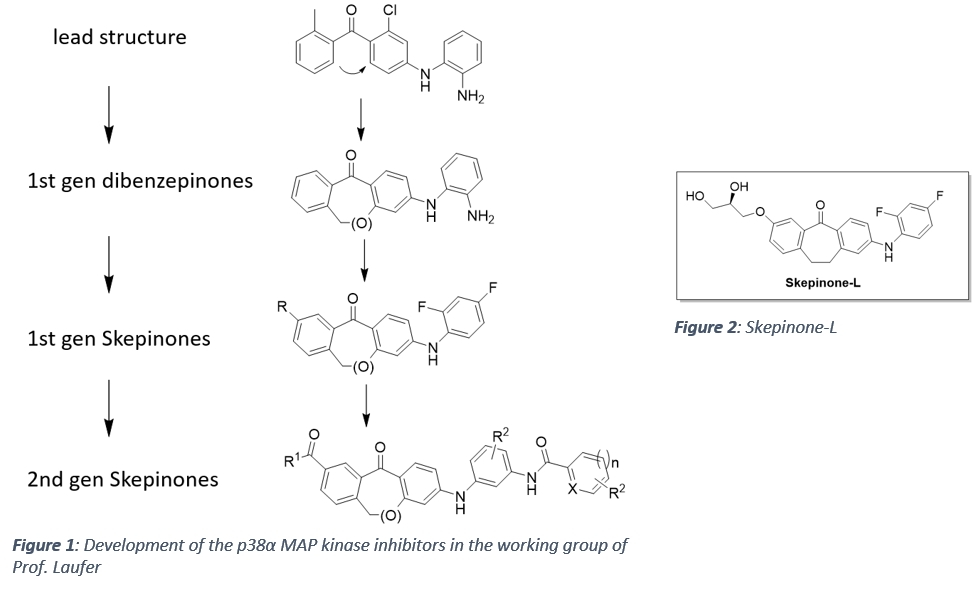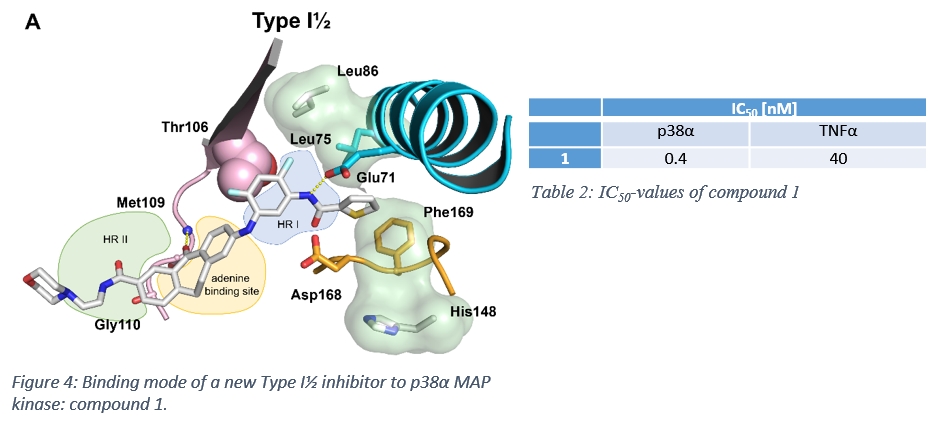The path of p38α MAP kinase inhibition
The p38α MAP kinase plays an important role in the regulation of biosynthesis of proinflammatory cytokines like interleukin 1β (Il-1β), tumor necrosis factor-alpha (TNFα) and the oncogenic activating transcription factor 2 (ATF-2)1, which are capable to induce and preserve severe diseases.2 Thus, current studies focus on the crucial role of p38 MAPK in processes such as cancer3, angiogenesis4 and apoptosis5. Concerning the importance of p38α MAP kinase our group started with the improvement of substituted isoxazoles6 and diarylpurinones7 as well as the progression of a rigidized benzophenone lead structure of LEO-Pharma8 to the first generation of dibenzepinones.9-11

These efforts yielded Skepinone-L as a highly potent and selective high quality probe for p38α MAP kinase (Table 1).12 The excellent selectivity of Skepinone-L is achieved by inducing a glycine-flip at the hinge region and addressing both hydrophobic regions I (HR I) and II (HR II) (Figure 3).

A further attachment to the difluorophenyl-ring of Skepinone-L led to the next generation of Skepinones (Figure 1). With these compounds, the potency of Skepinone-L could be increased and binding kinetics could be optimized. The underlying mechanisms lie in the establishment of the Type I½ binding concept to p38α MAP kinase.13 In fact, Type I½ inhibitors are additionally binding to the DFG-motif and the R-Spine of the kinase, resulting in picomolar potency on the enzyme and low nanomolar potency in human whole blood (Table 2).14 Another benefit of Type I½ inhibitors is their feature to bind to the inactive as well as the active form of the kinase effectively and their very good binding kinetics, expresses in target residence times of up to 3663 s (Table 3).14


1. Vlahopoulos, S. A.; Logotheti, S.; Mikas, D.; Giarika, A.; Gorgoulis, V.; Zoumpourlis, V., The role of ATF-2 in oncogenesis. BioEssays : news and reviews in molecular, cellular and developmental biology 2008, 30 (4), 314-27.
2. Cuenda, A.; Rousseau, S., p38 MAP-kinases pathway regulation, function and role in human diseases. Biochimica et biophysica acta 2007, 1773 (8), 1358-75.
3. Wagner, E. F.; Nebreda, A. R., Signal integration by JNK and p38 MAPK pathways in cancer development. Nature Reviews Cancer 2009, 9 (8), 537-549.
4. Veillat, V.; Carli, C.; Metz, C. N.; Al-Abed, Y.; Naccache, P. H.; Akoum, A., Macrophage Migration Inhibitory Factor Elicits an Angiogenic Phenotype in Human Ectopic Endometrial Cells and Triggers the Production of Major Angiogenic Factors via CD44, CD74, and MAPK Signaling Pathways. J Clin Endocr Metab 2010, 95 (12), E403-E412.
5. Xie, N. C.; Li, H.; Wei, D. L.; LeSage, G.; Chen, L.; Wang, S. J.; Zhang, Y.; Chi, L. Y.; Ferslew, K.; He, L.; Chi, Z. F.; Yin, D. L., Glycogen synthase kinase-3 and p38 MAPK are required for opioid-induced microglia apoptosis. Neuropharmacology 2010, 59 (6), 444-451.
6. Laufer, S. A.; Margutti, S.; Fritz, M. D., Substituted isoxazoles as potent inhibitors of p38 MAP kinase. ChemMedChem 2006, 1 (2), 197-207.
7. Hauser, D. R.; Scior, T.; Domeyer, D. M.; Kammerer, B.; Laufer, S. A., Synthesis, biological testing, and binding mode prediction of 6,9-diarylpurin-8-ones as p38 MAP kinase inhibitors. J Med Chem 2007, 50 (9), 2060-6.
8. Ottosen, E. R.; Sorensen, M. D.; Bjorkling, F.; Skak-Nielsen, T.; Fjording, M. S.; Aaes, H.; Binderup, L., Synthesis and structure-activity relationship of aminobenzophenones. A novel class of p38 MAP kinase inhibitors with high antiinflammatory activity. J Med Chem 2003, 46 (26), 5651-62.
9. Baur, B.; Storch, K.; Martz, K. E.; Goettert, M. I.; Richters, A.; Rauh, D.; Laufer, S. A., Metabolically Stable Dibenzo[b,e]oxepin-11(6H)-ones as Highly Selective p38 MAP Kinase Inhibitors: Optimizing Anti-Cytokine Activity in Human Whole Blood. J Med Chem 2013, 56 (21), 8561-8578.
10. Martz, K. E.; Dorn, A.; Baur, B.; Schattel, V.; Goettert, M. I.; Mayer-Wrangowski, S. C.; Rauh, D.; Laufer, S. A., Targeting the Hinge Glycine Flip and the Activation Loop: Novel Approach to Potent p38α Inhibitors. J Med Chem 2012, 55 (17), 7862-7874.
11. Fischer, S.; Wentsch, H. K.; Mayer-Wrangowski, S. C.; Zimmermann, M.; Bauer, S. M.; Storch, K.; Niess, R.; Koeberle, S. C.; Grutter, C.; Boeckler, F. M.; Rauh, D.; Laufer, S. A., Dibenzosuberones as p38 mitogen-activated protein kinase inhibitors with low ATP competitiveness and outstanding whole blood activity. J Med Chem 2013, 56 (1), 241-53.
12. Koeberle, S. C.; Romir, J.; Fischer, S.; Koeberle, A.; Schattel, V.; Albrecht, W.; Grutter, C.; Werz, O.; Rauh, D.; Stehle, T.; Laufer, S. A., Skepinone-L is a selective p38 mitogen-activated protein kinase inhibitor. Nature chemical biology 2012, 8 (2), 141-3.
13. Wentsch, H. K.; Walter, N. M., A Lesson in Target Residence Time: New Binding Mode of Type I½ Inhibitors for p38α MAP Kinase with Improved Kinetics by Targeting the R-Spine. Angew Chem Int Ed Engl 2017, in revision.
14. Wentsch, H. K.; Walter, N. M.; Buhrmann, M.; Mayer-Wrangowski, S.; Rauh, D.; Zaman, G. J.; Willemsen-Seegers, N.; Buijsman, R. C.; Henning, M.; Dauch, D.; Zender, L.; Laufer, S., Optimized Target Residence Time: Type I1/2 Inhibitors for p38alpha MAP Kinase with Improved Binding Kinetics through Direct Interaction with the R-Spine. Angew Chem Int Ed Engl 2017.
